Solution Manual for Organic Chemistry
7th Edition Brown Iverson
Anslyn Foote 11339528449781133952848
Full link download:
Test Bank:
https://testbankpack.com/p/test-bank-for-organic-chemistry-7th-edition-browniverson-anslyn-foote-1133952844-9781133952848/
Solution Manual:
https://testbankpack.com/p/solution-manual-for-organic-chemistry-7th-editionbrown-iverson-anslyn-foote-1133952844-9781133952848/
CHAPTER 1
Solutions to the Problems
Problem 1.1 Write and compare the ground-state electron configurations for each pair of elements:
(a) Carbon and silicon
C (6 electrons) 1s22s22p2
Si (14 electrons) 1s22s22p63s23p2
Both carbon and silicon have four electrons in their outermost (valence) shells.
(b) Oxygen and sulfur
O (8 electrons) 1s22s22p4
S (16 electrons) 1s22s22p63s23p4
Both oxygen and sulfur have six electrons in their outermost (valence) shells.
(c) Nitrogen and phosphorus
N (7 electrons) 1s22s22p3
P (15 electrons) 1s22s22p63s23p3
Both nitrogen and phosphorus have five electrons in their outermost (valence) shells.
Problem 1.2 Show how each chemical change leads to a stable octet.
(a) Sulfur forms S2-
S (16 electrons): 1s22s22p63s23p4
S2- (18 electrons): 1s22s22p63s23p6
(b) Magnesium forms Mg2+
Mg (12 electrons): 1s22s22p63s2
Mg2+ (10 electrons): 1s22s22p6
Problem 1.3 Judging from their relative positions in the Periodic Table, which element in each set is more electronegative?
(a) Lithium or potassium
In general, electronegativity increases from left to right across a row and from bottom to top of a column in the Periodic Table This is because electronegativity increases with increasing positive charge on the nucleus and with decreasing distance of the valence electrons from the nucleus. Lithium is closer to the top of the Periodic Table and thus more electronegative than potassium.
(b) Nitrogen or phosphorus
Nitrogen is closer to the top of the Periodic Table and thus more electronegative than phosphorus.
(c) Carbon or silicon
Carbon is closer to the top of the Periodic Table and thus more electronegative than silicon.
Problem 1.4 Classify each bond as nonpolar covalent, or polar covalent, or state that ions are formed.
(a) S-H (b) P-H (c) C-F (d) C-Cl
Recall that bonds formed from atoms with an electronegativity difference of less than 0.5 are considered nonpolar covalent and with an electronegativity difference of 0.5 or above are considered a polar covalent bond.
Problem 1.5 Using the symbols δ- and δ+, indicate the direction of polarity in each polar covalent bond.
(a) C-N (b) N-O
δ+ δ- δ+ δC-N N-O
Nitrogen is more electronegative than carbon Oxygen is more electronegative than nitrogen
(c) C-Cl
δ+ δC-Cl
Chlorine is more electronegative than carbon
Problem 1.6 Draw Lewis structures, showing all valence electrons, for these molecules.
(a) C2H6 (b) CS2
(c) HCN H H H
Problem 1.7 Draw Lewis structures for these ions, and show which atom in each bears the formal charge.
(a) CH3NH3 + (b) CO32- (c) HOMethylammonium ion Carbonate ion Hydroxide ion
Problem 1.8 Draw Lewis structures and condensed structural formulas for the four alcohols with molecular formula C4H10O. Classify each alcohol as primary, secondary, or tertiary.
Problem 1.11 Draw condensed structural formulas for the two carboxylic acids with molecular formula C4H8O2.
Problem 1.12 Draw structural formulas for the four esters with molecular formula C4H8O2
Problem 1.13 Predict all bond angles for these molecules.
(a) CH3OH
(b) PF3
(c) H2CO3 (Carbonic Acid)
MCAT Practice: Questions
Fullerenes
1 They are all tetrahedral.
2 They are all trigonal planar.

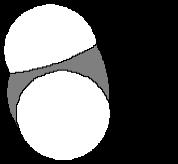




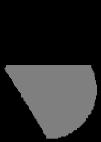


A The geometry of carbon in diamond is tetrahedral, while carbon’s geometry in graphite is trigonal planar What is the geometry of the carbons in C60?
3 They are all pyramidal with bond angles near 109.5°.
4. They are not perfectly trigonal planar but have an extent of pyramidalization. The curve of the buckyball surface is curved requiring some extent of pyramidilization.
B Because of their spherical shape, C60 moleclues are used as nanoscale ball bearings in grease and lubricants We can estimate the size of these ball bearings by examining C-C bond distances. Carbon-carbon bond distances vary between approximately 120pm (pm = picometers) and 155pm Roughly, what is the diameter of C60?
1 10 pm
2 100 pm
3 1,000 pm C60 is approximately 8 bonds across so approximately 1,000 pm in diameter.
4 10,000 pm
C What best describes the C-C-C bond angles in C60?
1 They are exactly 120o
2 They are a bit larger than 120o
3 They are a bit smaller than 120o The five-membered rings in the C
60
4. They are near 109.5°. structure reduce bond angles.
Problem 1.14 Which molecules are polar? For each molecule that is polar, specify the direction of its dipole moment.
(a) CH2Cl2
A molecular dipole moment is determined as the vector sum of the bond dipoles in three-dimensional space Thus, by superimposing the bond dipoles on a three-dimensional drawing, the molecular dipole moment can be determined. Note that on the following diagrams, the dipole moments from the C-H bonds are ignored because they are small. Cl
µ = 1.60 D C H Cl H
(b) HCN
µ = 2 98 D H C N


(c) H2O2


The H2O2 molecule can rotate around the O-O single bond, so we must consider the molecular dipole moments in the various possible conformations Conformations such as the one on the left have a net molecular dipole moment, while conformations such as the one the right below do not. The presence of at least some conformations (such as that on the left) that have a molecular dipole moment means that the entire molecule must have an overall dipole moment, in this case µ = 2.2 D.
µ = 2.2 D
Problem 1.15 Describe the bonding in these molecules in terms of hybridization of C and N, and the types of bonds between carbon and nitrogen, and if there are any lone pairs, describe what type of orbital contains these electrons. (a)
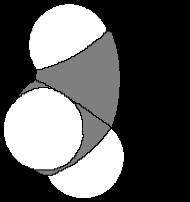

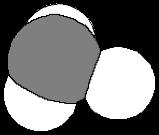
Problem 1.16 Draw the contributing structure indicated by the curved arrows Show all valence electrons and all formal charges.
Problem 1.17 Which sets are valid pairs of contributing structures?
The set in (a) is a pair of contributing structures, while the set in (b) is not. The structure on the right in set (b) is not a viable contributing structure because there are five bonds to the carbon atom, implying 10 electrons in the valence shell, which can only hold a maximum of 8 electrons.
Problem 1.18 Estimate the relative contribution of the members in each set of contributing structures.
The first structure makes the greater contribution in (a) and (b). In both cases, the second contributing structure involves the disfavored creation and separation of unlike charges.
Problem 1.19 Draw three contributing structures of the following compound (called guanidine) and state the hybridization of the four highlighted atoms In which orbitals do the three lone pairs drawn reside
Remember that if any significant contributing structure contains a π bond, then the hybridization of that atom must be able to accommodate the π bond. Consideration of the three significant contributing structures indicates that all of the nitrogen atoms are sp2 hybridized because of the π bonding. To be consistent with the contributing structures, two of the lone pairs on the original structure are in 2p orbitals, while the third resides in an sp2 orbital. Guanidine is one of many examples you will encounter in which the lone pair on nitrogen is delocalized into an adjacent π bond. Such delocalization of electron density in π orbitals is stabilizing and therefore favorable, a phenomenon that is best explained using quantum mechanical arguments (beyond the scope of this text). sp2
MCAT Practice: Questions
Histidine
A What is the hybridization state of the circled nitrogens. What kind of orbital contains the lone pairs identified in these circles?
1. sp, 2p
2. sp2 , sp2
3. sp3 , 2p
4. sp 2 , 2p The circled N atoms are each part of delocalized pi systems explaining their sp 2 hybridization. Write contributing structures to help understand this point An sp 2 hybridized N atom with bonds to three other atoms must have the lone pair in 2p orbital.
B The molecule shown on the right in the example is the amino acid histidine, and the five-membered ring is known as aromatic An aromatic ring has 2, 6, 10, or 14, etc electrons placed in p-orbitals around a ring Indicate which statements must therefore also be true.
1 There are a total of 6 electrons in the pi system (defined as electrons in p-orbitals), including the lone pair that is on the ring N that is not circled.
2 There are a total of 6 electrons in the pi system, including the lone pair that is on the ring N atom that is circled.
3 The lone pair on the ring N atom that is not circled resides in an sp 2 orbital on an sp 2 hybridized nitrogen atom.
4 Both B and C A lone pair will be part of an aromatic pi system if it contributes to the aromatic number (in this case 6 pi electrons) like the circled N atom, while a lone pair will be in an sp2 orbital of the N atom already has a pi bond without counting the lone pair like the non-circled N atom.
C Which of the following are reasonable contributing structures for the amide bond of the molecule shown on the left in the example above ?
1 Figure 1
2 Figure 2
3. Figure 3
4. Both Figures 1 and 3. Figure 2 makes no sense because it involves removal of an H atom so is therefore not a contributing structure. Both 1 and 3 are reasonable contributing structures for an amide bond.
D) The following structure is called imidazolium Which of the following statements about imidazolium are true?
Imidazolium
a. Both nitrogens are sp 2 hybridized, and the lone pair of electrons is in 2p orbitals.
b. The nitrogen on the right is sp 3 hybridized while the nitrogen on the left is sp 2 hybridized, and the lone pair of electrons shown is in an sp 3 hybrid orbital.
c. The molecule has an identical contributing structure not shown.
d. Themolecule hasnoreasonable contributing structures.
1. Statements a. and c. are true. Both N atoms in imidazolium are sp 2 hybridized and there is a symmetric contributing structure that moves the upper double bond and interconverts the locations of the plus charge and lone pair as shown above.
2 Statements a and d are true.
3. Statements b. and c. are true.
4 Statements b and d are true.
Electronic Structures of Atoms
Problem 1.20 Write ground-state electron configuration for each atom. After each atom is its atomic number in parentheses.
(c)
(d) Nitrogen (7) N (7 electrons) 1s22s22p3
Problem 1.21 Identify the atom that has each ground-state electron configuration.
(a) 1s22s22p63s23p4
Sulfur (16) has this ground-state electron configuration
(b) 1s22s22p4
Oxygen (8) has this ground-state electron configuration
Problem 1.22 Define valence shell and valence electron.
The valence shell is the outermost occupied shell of an atom. A valence electron is an electron in the valence shell.
Problem 1.23 How many electrons are in the valence shell of each atom?
(a) Carbon
With a ground-state electron configuration of 1s22s22p2 , there are four electrons in the valence shell of carbon.
(b) Nitrogen
With a ground-state electron configuration of 1s22s22p3 , there are five electrons in the valence shell of nitrogen.
(c) Chlorine
With a ground-state electron configuration of 1s22s22p63s23p5 , there are seven electrons in the valence shell of chlorine.
(d) Aluminum
With a ground-state electron configuration of 1s22s22p63s23p1 , there are three electrons in the valence shell of aluminum.
Lewis Structures and Formal Charge
Problem 1.24 Judging from their relative positions in the Periodic Table, which atom in each set is more electronegative?
(a) Carbon or nitrogen
In general, electronegativity increases from left to right across a row (period) and from bottom to top of a column in the Periodic Table. This is because electronegativity increases with increasing positive charge on the nucleus and with decreasing distance of the valence electrons from the nucleus. Nitrogen is farther to the right than carbon in Period 2 of the Periodic Table. Thus, nitrogen is more electronegative than carbon.
(b) Chlorine or bromine
Chlorine is higher up than bromine in column 7A of the Periodic Table. Thus, chlorine is more electronegative than bromine.
(c) Oxygen or sulfur
Oxygen is higher up than sulfur in column 6A of the Periodic Table. Thus, oxygen is more electronegative than sulfur.
Problem 1.25 Which compounds have nonpolar covalent bonds, which have polar covalent bonds, and which have ions?
(a) LiF (b) CH3F (c) MgCl2 (d) HCl
Using the rule that ions are formed between atoms with an electronegativity difference of 1.9 or greater, the following table can be constructed:
Based on these values, only LiF has ions. The other compounds have nonpolar covalent (C-H) or polar covalent (C-F, Mg-Cl, H-Cl) bonds.
Problem 1.26 Using the symbols δ- and δ+, indicate the direction of polarity, if any, in each covalent bond. δ + δ
(a) C-Cl C-Cl Chlorine is more electronegative than carbon.
(b) S-H δ δ + S-H Sulfur is more electronegative than hydrogen.
(c) C-S Carbon and sulfur have the same electronegativity so there is no polarity in a C-S bond.
(d) P-H Phosphorus and hydrogen have the same electronegativity, so there is no polarity in a P-H bond.
Problem 1.27 Write Lewis structures for these compounds Show all valence electrons None of them contains a ring of atoms.
(a) H2O2 (b) N2H4
(c) CH3OH Hydrogen peroxide Hydrazine Methanol
Problem 1.28 Write Lewis structures for these ions Show all valence electrons and all formal charges.
(a) NH2 - (b) HCO3 - (c) CO32Amide ion Bicarbonate ion Carbonate ion
(d) NO3 -
(e) HCOO-
(f) CH3COONitrate ion Formate ion Acetate ion
Problem 1.29 Complete these structural formulas by adding enough hydrogens to complete the tetravalence of each carbon Then write the molecular formula of each compound.
Lone pairs were added to the following structural formulas for clarity.
Problem 1.30 Some of these structural formulas are incorrect (i.e they do not represent a real compound) because they have atoms with an incorrect number of bonds Which structural formulas are incorrect, and which atoms in them have an incorrect number of bonds?
(a)
(g)
The molecules in (a), (b), (d), and (f) are incorrect, because there are five bonds to the circled carbon atom, not four.
Problem 1.31 Following the rule that each atom of carbon, oxygen, and nitrogen reacts to achieve a complete outer shell of eight valence electrons, add unshared pairs of electrons as necessary to complete the valence shell of each atom in these ions Then assign formal charges as appropriate.
The following structural formulas show all valence electrons and all formal charges for clarity.
(a)
Problem 1.32 Following are several Lewis structures showing all valence electrons Assign formal charges in each structure as appropriate.
There is a positive formal charge in parts (a), (e), and (f). There is a negative formal charge in parts (b), (c), and (d).
(a)
(d)
Polarity of Covalent Bonds
Problem 1.33 Which statements are true about electronegativity?
(a) Electronegativity increases from left to right in a period of the Periodic Table.
(b) Electronegativity increases from top to bottom in a column of the Periodic Table.
(c) Hydrogen, the element with the lowest atomic number, has the smallest electronegativity.
(d) The higher the atomic number of an element, the greater its electronegativity.
Electronegativity increases from left to right across a period and from bottom to top of a column in the Periodic Table. Thus, statement (a) is true, but (b), (c), and (d) are false.
Problem 1.34 Why does fluorine, the element in the upper right corner of the Periodic Table, have the largest electronegativity of any element?
Electronegativity increases with increasing positive charge on the nucleus and with decreasing distance of the valence electrons from the nucleus. Fluorine is that element for which these two parameters lead to maximum electronegativity.
Problem 1.35 Arrange the single covalent bonds within each set in order of increasing polarity.
(a) C-H, O-H, N-H (b) C-H, B-H, O-H (c) C-H, C-Cl, C-I
C-H < N-H < O-H B-H < C-H < O-H C-I < C-H < C-Cl
(d) C-S, C-O, C-N
(e) C-Li, C-B, C-Mg
C-S < C-N < C-O C-B < C-Mg < C-Li
Problem 1.36 Using the values of electronegativity given in Table 1.5, predict which indicated bond in each set is the more polar and, using the symbols δ+ and δ, show the direction of its polarity
(a) CH3-OH or CH3O-H
(b) CH3-NH2 or CH3-PH2
δ - δ + CH3O-H δ + δH3C-NH2
(c) CH3-SH or CH3S-H
(d) CH3-F or H-F
δ δ + δ + δCH3S-H H-F
Problem 1.37 Identify the most polar bond in each molecule.
(a) HSCH2CH2OH
The O-H bond
(b) CHCl2F
The C-F bond
(c) HOCH2CH2NH2
The O-H bond (1.4) (1.5) (1.4)
The difference in electronegativities is given in parentheses underneath each answer.
Bond Angles and Shapes of Molecules
Problem 1.38 Use VSEPR to predict bond angles about each highlighted atom.
Approximate bond angles as predicted by valence-shell electron-pair repulsion are as shown.
109 5°
(a)
(b) H C C
(c) H C C C H H
(d) H C O
109 5o H
(e) H O



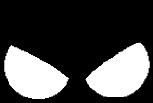
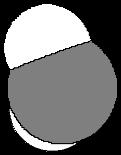








109 5°
H
(f) H C N H H H



Problem 1.39 Use VSEPR to predict bond angles about each atom of carbon, nitrogen, and oxygen in these molecules.
109.5o 120o
(a) CH3 CH CH2
109 5o CH3
(b) CH3 N CH3
109 5o
109 5o 120o
(c) CH3 CH2 C O H
109 5o
120o
(d) CH2 C 180o CH2 120o
(e) CH2 C O 180o o
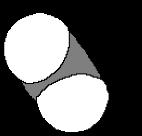
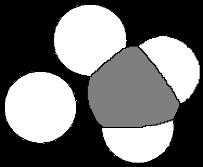
109.5o 109 5
(f) CH3 CH N O H
120o
(a) NH2H N H Bent
109 5o
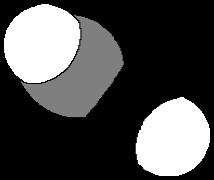
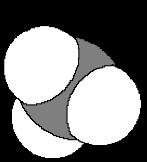
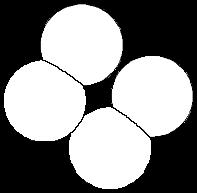

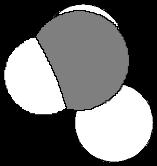


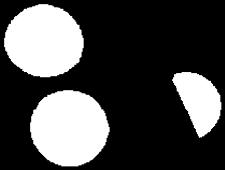
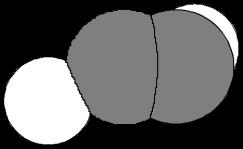


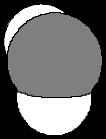

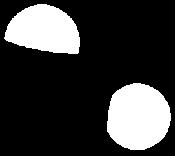
Problem 1.40 Use VSEPR to predict the geometry of these ions.

(b) NO2120o
Bent
(c) NO2+ o180
Linear
(d) NO3O 120o
Trigonal planar
Functional Groups









Problem 1.41 Draw Lewis structures for these functional groups. Be certain to show all valence electrons on each.
(a) Carbonyl group
(b) Carboxyl group
(c) Hydroxyl group
(d) Ester group
(e) Amide group
Problem 1.42 Draw condensed structural formulas for all compounds with the molecular formula C4H8O that contain (a) A carbonyl group (there are two aldehydes and one ketone).
Ketone
Aldehydes
(b) A carbon-carbon double bond and a hydroxyl group (there are eight)
There are three separate but related things to build into this answer; the carbon skeleton (the order of attachment of carbon atoms), the location of the double bond, and the location of the -OH group. Here, as in other problems of this type, it is important to have a system and to follow it. As one way to proceed, first decide the number of different carbon skeletons that are possible. A little doodling with paper and pencil should convince you that there are only two. C-C-C-C and C C C C
Next locate the double bond on these carbon skeletons. There are three possible locations for it. C C C C C and C C C C and C C C
Finally, locate the -OH group and then add the remaining seven hydrogens to complete each structural formula. For the first carbon skeleton, there are four possible locations of the -OH group; for the second carbon skeleton there are two possible locations; and for the third, there are also two possible locations. Four of these compounds (marked by a # symbol) are not stable and are in equilibrium with a more stable aldehyde or ketone. You need not be concerned, however, with this now. Just concentrate on drawing the required eight condensed structural formulas. #OH OH
Problem 1.43 What is the meaning of the term tertiary (3°) when it is used to classify alcohols? Draw a structural formula for the one tertiary (3°) alcohol with the molecular formula C4H10O.
A tertiary alcohol is one in which the -OH group is on a tertiary carbon atom. A tertiary carbon atom is one that is bonded to three other carbon atoms.
Problem 1.44 What is the meaning of the term tertiary (3°) when it is used to classify amines? Draw a structural formula for the one tertiary (3°) amine known as Hunig’s base (N,N-diisopropylethylamine).
Problem 1.45 Draw structural formulas for
(a) The four primary (1°) amines with the molecular formula C4H11
Another random document with no related content on Scribd:
jealous indeed So great was his passion for her that he had threatened to kill her and himself if she did not give up Keene, which, according to her, made her care all the more for Keene. When Browne could stand it no longer and was fearful lest Keene was to capture the prize—which he was not, of course, Idelle being a mere trifler at all stages—he had invited her out on that disastrous automobile ride—
A mere form, eating, this morning! No appetite—due to his troubled thoughts, of course, these days!
—which had ended in her being carried into his presence at the Insull General. Browne must have been vividly in love with her to prefer to kill himself and her in that fashion rather than lose her, for, according to her, he had swung the car squarely into the rocks at Saltair Brook, only it never came out in the papers, and neither Idelle nor Browne would tell.
All railway cars seemed so soiled toward the end of a ride like this!
She professed afterwards to be sorry for Browne and inquired after him every day, although, of course, she had no sympathy for him or Keene, either,—for no man whom she could engage in any such contest. She was too wholly interested in following her own selfish bent. Afterward, when Keene was calling daily and trying to find out how it really did happen, and Coulstone was still in evidence and worrying over her condition (and old Candia also, he presumed —how could he tell whom all she had in tow at that time?), she refused to tell them, or any of a half dozen others who came to inquire. Yet right on top of all that she had encouraged him, Garrison, to fall in love with her, and had even imagined herself, or so she sneeringly charged, whenever they quarreled, in love with him, ready to reform and lead a better life, and had finally allowed him to carry her off and marry her in the face of them all! What were you to make of a creature like that? Insanity, on his or her part? Or both? Both, of course.
Kenelm! They were certainly speeding on! Those four wooden cows in that field, advertising a brand of butter!
But she could be so agreeable when she chose to be, and was so fascinatingly, if irritatingly, beautiful all the time!
There was no doubt, though, that things were now reaching such a state that there would have to be a change. He couldn’t stand this any longer. Women like Idelle were menaces, really, and shouldn’t be tolerated. Most men wouldn’t stand for her, although he had. But why? Why? Well, because he loved her, that was why, and you couldn’t explain love. And the other reason—the worst of all—was the dread he had been suffering of late years of being left alone again if she left him. Alone! It was a terrible feeling, this fear of being left alone in the future, and especially when you were so drawn to some one who, whatever her faults, could make you idyllically happy if she only would. Lord, how peculiar these love passions of people were, anyhow! How they swayed one! Tortured one! Here he was haunted all the time now by the knowledge that he would be miserable if she left him, and that he needed some one like her to make him happy, a cheerful and agreeable beauty when she chose to be, fascinating even when she was not, and yet knowing that he would have to learn to endure to be alone if ever he was to get the strength to force her to better ways. Why couldn’t he? Or why couldn’t she settle down and be decent once? Well, he would have to face this out with her, once and for all now. He wasn’t going to stand for her carrying on in this fashion. She must sober down. She had had her way long enough now, by God! He just wasn’t going to pose as her husband and be a shield for her any longer! No sir, by George.
Only thirty-eight miles more! If she were not there now, as she promised!
Beginning to-day she would have to give him a decent deal or he would leave her He wouldn’t—he couldn’t—stand for it any longer Think of that last time he had come on from K——, just as he was coming to-day, and she had agreed to be at home—because he had made her promise before going that she would—and then, by George, when he got off the train and walked into the Brandingham with Arbuthnot to telephone, having just told Arbuthnot that he
expected to find her out at the house, wasn’t she there with young Keene and four or five others, drinking and dancing?
“Why, there’s your wife now, Garrison,” Arbuthnot had laughingly jested, and he had had to turn it all off with that “Oh, yes, that’s right! I forgot! She was to meet me here. How stupid of me!”
Why hadn’t he made a scene then? Why hadn’t he broken things up then? Because he was a blank-blanked fool, that’s why, allowing her to pull him around by the nose and do as she pleased! Love, that’s why! He was a damned fool for loving her as much as he did, and in the face of all he knew!
Nearing Shively! Colonel Brandt’s stock-farm! Home soon now! That little town in the distance, no connection with the railroad at all!
On that particular occasion, when at last they were in a taxi, she had begun one of her usual lies about having come downtown for something—a romper for Tatty—only when he ventured to show her what she was doing to herself and him socially, that he was being made a fool of, and that he really couldn’t stand it, hadn’t she flown into the usual rage and exclaimed: “Oh, all right! Why don’t you leave me then? I don’t care! I don’t care! I’m bored! I can’t help it! I can’t always sit out in Sicard Avenue waiting for you!”
In Sicard Avenue. And that on top of always refusing to stay out there or to travel with him anywhere or to meet him and go places! Think of that for a happy married life, will you? Love! Love! Yes, love! Hell!
Well, here was Lawndale now, only eighteen miles—that meant about eighteen minutes from here, the way they were running now— and he would soon see her now if she was at home. If she only were, just this one time, to kiss him and laugh and ask about the trip and how he had made out, and let him propose some quiet dinner somewhere for just the two of them, a quiet dinner all to themselves, and then home again! How delightful that would be! Only— No doubt Charles would be at the station with the jitney, as he always called the yellow racer. He would have to summon all his ease to make his
inquiry, for one had to keep one’s face before the servants, you know —but then it was entirely possible that Charles wouldn’t know whether she was home or not. She didn’t always tell the servants. If she wasn’t there, though—and after that letter and telegram— Well —now—this time!—by God!—
Wheelwright! They were running a little later, perhaps, but they would enter the station nearly on time!
But take, again, that last affair, that awful scene in the Shackamaxon at C——, when without his knowing it she had gone down there with Bodine and Arbuthnot and that wretched Aikenhead. Think of being seen in a public place like the Shackamaxon with Aikenhead and two such other wasters (even if Mrs. Bodine were along—she was no better than the others!), when she was already married and under so much suspicion as it was. If it weren’t for him she would have been driven out of society long ago! Of course she would have! Hadn’t General and Mrs. de Pasy cut her dead on that occasion?—only when they saw that he had joined her they altered their expressions and were polite enough, showing what they would do if they had to deal with her alone.
That brown automobile racing this train! How foolish some automobilists were!
Well, that time, coming home and finding her away, he had run down to C—— on the chance of finding her there—and sure enough there she was dancing with Aikenhead and Bodine by turns, and Mrs. Bodine and that free Mrs. Gildas and Belle Geary joining them later. And when he had sought her out to let her know he was back quite safe and anxious to see her, hadn’t she turned on him with all the fury of a wildcat—“Always following me up and snooping around after me to catch me in something!” and that almost loud enough for all the others to hear! It was terrible! How could anybody stand for such a thing! He couldn’t, and retain his self-respect. And yet he had —yes, he had, more shame to him! But if it hadn’t been that he had been so lonely just beforehand and so eager to see her, and hadn’t had those earrings for her in his pocket—thinking they would please her—perhaps he wouldn’t have done as he did, backed down so. As
it was—well, all he could think of at the moment was to apologize— to his own wife!—and plead that he hadn’t meant to seem to follow her up and “snoop around.” Think of that! Hang it all, why hadn’t he left her then and there? Supposing she didn’t come back?
Supposing she didn’t? What of it? What of it? Only—
“This way out, please.”
Well, here was G—— at last, and there was Charles, well enough, waiting as usual. Would she be home now? Would she? Perhaps, after all, he had better not say anything yet, just go around to Kiralfy’s and get the flowers. But to what end, really, if she weren’t there again? What would he do this time? Surely this must be the end if she weren’t there, if he had any strength at all. He wouldn’t be put upon in this way again, would he?—after all he had told himself he would do the last time if ever it happened again! His own reputation was at stake now, really. It depended on what he did now. What must the servants think—his always following her up and she never being there or troubling about him in the least?
“Ah, Charles, there you are! To Kiralfy’s first, then home!”
She was making him a laughing-stock, or would if he didn’t take things in hand pretty soon to-day, really—a man who hung onto a woman because she was young and pretty, who tolerated a wife who did not care for him and who ran with other men—a sickening, heartless social pack—in his absence. She was pulling him down to her level, that’s what she was doing, a level he had never deemed possible in the old days. It was almost unbelievable—and yet— But he would go in and get the flowers, anyway!
“Back in a minute, Charles!”
And now here was Sicard Avenue, again, dear old Sicard, with its fine line of trees on either side of its broad roadway, and their own big house set among elms and with that French garden in front—so quiet and aristocratic! Why couldn’t she be content with a place like this, with her present place in society? Why not? Why not be happy in it? She could be such an interesting social figure if she chose, if
she would only try But no, no—she wouldn’t. It would always be the same until—until—
The gardener had trimmed the grass again, and nicely!
“No, suh, Mr. Garrison,” George was already saying in that singsong darky way of his as he walked up the steps ahead of him, and just as he expected or feared he would. It was always the way, and always would be until he had courage enough to leave once and for all—as he would to-day, by George! He wouldn’t stand for this one moment longer—not one. “Mrs. Garrison she say she done gone to Mrs. Gildas’” (it might just as well have been the Bodines, the Del Guardias or the Cranes—they were all alike), “an’ dat yo’ was to call her up dere when yo’ come in or come out. She say to say she lef’ a note fo’ yo’ on yo’ dresser.”
Curse her! Curse her! Curse her! To be treated like this all the time! He would fix her now, though, this time! Yes, he would. This time he wouldn’t change his mind.
And the brass on the front door not properly cleaned, either!
“George,” this to his servant as the latter preceded him into his room—their room—where he always so loved to be when things were well between them, “never mind the bags now. I’ll call you later when I want you,” and then, as the door closed, almost glaring at everything about him. There in the mirror, just above his military brushes, was stuck a note—the usual wheedling, chaffering rot she was inclined to write him when she wanted to be very nice on such occasions as this. Now he would see what new lying, fooling communication she had left for him, where he would be asked to come now, what do, instead of her being here to receive him as she had promised, as was her duty really, as any decent married woman would—as any decent married man would expect her to be. Oh, the devil!
That fly buzzing in the window there, trying to get out!
What was the use of being alive, anyway? What the good of anything—money or anything else? He wouldn’t stand for this any
longer, he couldn’t—no, he couldn’t, that was all there was to it! She could go to the devil now; he wouldn’t follow her any more—never, never, never!—the blank-blank-blank-blank——! This was the end! This was the way she was always doing! But never again now, not once more! He’d get a divorce now! Now, by George, for once he would stand his ground and be a man, not a social door-mat, a humble beggar of love, hanging around hat in hand waiting for her favors! Never again, by God! Never!! Never!!! Only—
That letter of hers on the dresser there waiting for him, as usual!
“Dearest Old Judge: This isn’t the real one. This is just a hundred-kiss one, this. The real one is pinned to your pillow over there—our pillow—where it ought to be, don’t you think? I don’t want you to be unhappy at not finding me home, Judgie, see? And I don’t want you to get mad and quarrel. And I do want you to be sure to find the other letter. So don’t be angry, see? But call me up at the Gildas’. I’m dying to see you, dearie, really and truly I am! I’ve been so lonesome without you! (Yes!) You’re sure to find me out there. And you’re not to be angry—not one little frown, do you hear? I just couldn’t help it, dearest! So read the other letter now!
“I�����.”
If only his hands wouldn’t tremble so! Damn her! Damn her! Damn her! To think she would always treat him like this! To think he was never to have one decent hour of her time to himself, not one! Always this running here, there and everywhere away from him, as it were!
He crumpled up the note and threw it on the floor, then went to the window and looked out. There over the way at her own spacious door was young Mrs. Justus just entering her car—a simple, homeloving little woman, who would never dream of the treacheries and eccentricities of Idelle; who, if she even guessed what manner of woman she was, would never have anything more to do with her. Why couldn’t he have loved a girl like her—why not? And just
beyond, the large quiet house of the Walterses, those profoundly sober people of the very best ways and means, always so kind and helpful, anxious to be sociable, of whom Idelle could think of nothing better to say than “stuffy.” Anything kind and gentle and orderly was just stuffy to her, or dull. That was what she considered him, no doubt. That’s because she was what she was, curses on her! She couldn’t stand, or even understand, profoundly worthy people like the Justuses or the Walterses. (There was May Walters now at her dining-room window.) And then there were the Hartleys.... But that other note of hers—what did it say? He ought to read that now, whether he left or no; but he would leave this time, well enough!
He turned to the twin bed and from the fretted counterpane unpinned the second lavender-colored and scented note—the kind Idelle was always scribbling when she was doing things she shouldn’t. It didn’t make one hanged bit of difference now what she wrote, of course—only— He wouldn’t follow her this time; no, he wouldn’t! He wouldn’t have anything more to do with her ever! He would quit now, lock the doors in a few minutes, discharge the servants, cut off her allowance, tell her to go to blazes. He would go and live at a club, as he had so often threatened before to himself— or get out of G——, as he had also threatened. He couldn’t stand the comment that would follow, anyhow. He had had enough of it. He hated the damned city! He had never had any luck in it. Never had he been happy here, in spite of the fact that he had been born and brought up here, and twice married here—never! Twice now he had been treated like this by women right here in this city, his home town, where everybody knew! Twice he had been made a fool of, but this time—
The letter, though!
“Dearest and best of hubbies, I know you’re going to be disappointed at not finding me here, and in spite of anything I can say, probably terribly angry, too. (I wish you wouldn’t be, darling!) But, sweetheart, if you’ll only believe me this time (I’ve said that before when you wouldn’t, I know, and it wasn’t my fault, either), it wasn’t premeditated, really, it wasn’t! Honest, cross my heart, dear, twenty ways, and hope to die!”
(What did she really care for his disappointment or what he suffered, curse her!)
“Only yesterday at four Betty called up and insisted that I should come. There’s a big house party on, and you’re invited, of course, when you get back. Her cousin Frank is coming and some friends of his,”
(Yes, he knew what friends!)
“and four of my old girl chums, so I just couldn’t get out of it, nor would I, particularly since she wanted me to help her, and I’ve asked her so many times to help us—now, could I?”
Idelle’s way in letters, as in person, was always bantering. To the grave with Betty Gildas and all her house parties, in so far as he was concerned, the fast, restless, heartless thing! Why couldn’t she have been here just this once, when he wanted her so much and had wired and written in plenty of time for her to be!
But no, she didn’t care for him She never had. She merely wanted to fool him along like this, to keep his name, his position, the social atmosphere he could give her. This whole thing was a joke to her— this house, his friends, himself, all—just nothing! Her idea was to fool him along in this way while she continued to run with these other shabby, swift, restless, insatiable creatures like herself, who liked cabarets, thés dansants, automobile runs to this, that and the other wretched place, country house parties, country clubs, country this, country that, or New York and all its shallow and heartless mockery of simplicity and peace. Well, he was through. She was always weary of him, never anxious to be with him for one moment even, but never weary of any of them, you bet—of seeking the wildest forms of pleasure! Well, this was the end now. He had had enough. She could go her own way from now on. Let the beastly flowers lie there—what did he care? He wouldn’t carry them to her. He was through now. He was going to do what he said—leave. Only—
He began putting some things in another bag, in addition to the ones he had—his silk shirts, extra underwear, all his collars. Once and for all now he wouldn’t stand this—never! Never!
Only—
As he fumed and glared, his eye fell on his favorite photo of Idelle —young, rounded, sensuous, only twenty-four to his forty-eight, an air and a manner flattering to any man’s sense of vanity and possession—and then, as a contrast, he thought of the hard, smiling, self-efficiency of so many of her friends—J—— C——, for one, still dogging her heels in spite of him, and Keene, young and wealthy, and Arbuthnot—and who not else?—any one and all of whom would be glad to take her if he left her. And she knew this. It was a part of her strength, even her charm—curse her! Curse her! Curse her!
But more than that, youth, youth, the eternal lure of beauty and vitality, her smiling softness at times, her geniality, her tolerance, their long talks and pleasant evenings and afternoons. And all of these calling, calling now. And yet they were all at the vanishing point, perhaps never to come again, if he left her! She had warned him of that. “If I go,” she had once said—more than once, indeed —“it’s for good. Don’t think I’ll ever come back, for I won’t.” And he understood well enough that she would not. She didn’t care for him enough to come back. She never would, if she really went.
He paused, meditating, biting his lips as usual, flushing, frowning, darkening—a changeable sky his face—and then—
“George,” he said after the servant had appeared in answer to his ring, “tell Charles to bring the jitney around again, and you pack me the little brown kit bag out of these others. I’m going away for a day or two, anyhow.”
“Yes, suh!”
Then down the stairs, saying that Idelle was a liar, a wastrel, a heartless butterfly, worthy to be left as he proposed to leave her now. Only, once outside in his car with Charles at the wheel, and ready to take him wherever he said, he paused again, and then—sadly— “To the Gildases, and better go by the Skillytown road. It’s the shortest!”
Then he fell to thinking again.
ST. COLUMBA AND THE RIVER
THE first morning that McGlathery saw the great river stretching westward from the point where the initial shaft had been sunk he was not impressed by it—or, rather, he was, but not favorably. It looked too gray and sullen, seeing that he was viewing it through a driving, sleety rain. There were many ferry boats and craft of all kinds, large and small, steaming across its choppy bosom, giant steamers, and long projecting piers, great and mysterious, and clouds of gulls, and the shriek of whistles, and the clang of fogbells,... but he did not like water. It took him back to eleven wretched seasick days in which he had crossed on the steamer from Ireland. But then, glory be, once freed from the mysteries of Ellis Island, he had marched out on dry land at the Battery, cloth bags in hand, and exclaimed, “Thanks be, I’m shut av it!”
And he thought he was, for he was mortally afraid of water. But fate, alas! had not decreed it as a permanent thing. As a matter of fact, water in one form or another had persistently seemed to pursue him since. In Ireland, County Clare, from whence he hailed, he had been a ditcher—something remotely connected with water. Here in America, and once safely settled in Brooklyn, he had no sooner sought work than the best he could seemingly get was a job in connection with a marsh which was being drained, a very boggy and pool-y one—water again, you see. Then there was a conduit being dug, a great open sewer which once when he and other members of the construction gang were working on it, was flooded by a cloudburst, a tremendous afternoon rain-storm which drove them from it with a volume of water which threatened to drown them all. Still later, he and thirty others were engaged in cleaning out a twocompartment reservoir, old and stone-rotten, when, one-half being empty and the other full, the old dividing wall broke, and once more he barely escaped with his life by scrambling up a steep bank. It was
then that the thought first took root in his mind that water—any kind of water, sea or fresh—was not favorable to him. Yet here he was, facing this great river on a gray rainy November morning, and with the avowed object of going to work in the tunnel which was about to be dug under it.
Think of it! In spite of his prejudices and fears, here he was, and all due to one Thomas Cavanaugh, a fellow churchman and his foreman these last three years, who had happened to take a fancy to him and had told him that if he came to work in the tunnel and prosecuted his new work thoroughly, and showed himself sufficiently industrious and courageous, it might lead to higher things—viz., bricklaying, or plastering, in the guise of cement moulding, down in this very tunnel, or timbering, or better yet, the steel-plate-joining trade, which was a branch of the ironworkers’ guild and was rewarded by no less a compensation than twelve dollars a day. Think of it—twelve dollars a day! Men of this class and skill were scarce in tunnel work and in great demand in America. This same Cavanaugh was to be one of the foremen in this tunnel, his foreman, and would look after him. Of course it required time and patience. One had to begin at the bottom—the same being seventy-five feet under the Hudson River, where some very careful preliminary digging had to be done. McGlathery had surveyed his superior and benefactor at the time with uncertain and yet ambitious eyes.
“Is it as ye tell me now?” he commented at one place.
“Yis. Av course. What d’ye think I’m taalkin’ to ye about?”
“Ye say, do ye?”
“Certainly.”
“Well! Well! Belike it’s a fine job. I dunno. Five dollars a day, ye say, to begin with?”
“Yis, five a day.”
“Well, a man in my line could git no more than that, eh? It wouldn’t hurt me fer once, fer a little while anyway, hey?”
“It would be the makin’ av ye.”
“Well, I’ll be with ye. Yis, I’ll be with ye. It’s not five I can git everywhere. When is it ye’ll be wantin’ me?”
The foreman, a Gargantuan figure in yellow jeans and high rubber boots smeared to the buttocks with mud, eyed him genially and amiably, the while McGlathery surveyed his superior with a kind of reverence and awe, a reverence which he scarcely felt for any other man, unless perchance it might be his parish priest, for he was a good Catholic, or the political backer of his district, through whom he had secured his job. What great men they all were, to be sure, leading figures in his life.
So here he was on this particular morning shortly after the work had been begun, and here was the river, and down below in this new shaft, somewhere, was Thomas Cavanaugh, to whom he had to report before he could go to work.
“Sure, it’s no colleen’s job,” he observed to a fellow worker who had arrived at the mouth of the shaft about the same time as himself, and was beginning to let himself down the ladder which sank darkly to an intermediate platform, below which again was another ladder and platform, and below that a yellow light. “Ye say Mr. Cavanaugh is below there?”
“He is,” replied the stranger without looking up. “Ye’ll find him inside the second lock. Arr ye workin’ here?”
“Yis.”
“Come along, then.”
With a bundle which consisted of his rubber boots, a worn suit of overalls, and with his pick and shovel over his shoulder, he followed. He reached the bottom of the pit, boarded as to the sides with huge oak planks sustained by cross beams, and there, with several others who were waiting until the air pressure should be adjusted, entered the lock. The comparatively small and yet massive chamber, with its heavy iron door at either end, responding so slowly to pressure, impressed him. There was only a flickering light made by a gasoline torch here. There was a whistling sound from somewhere.
“Ever work under air pressure before, Paddy?” inquired a great hulking ironworker, surveying him with a genial leer.
“Air what?” asked McGlathery without the slightest comprehension of what was meant, but not to be outdone by mere words. “No, I never did.”
“Well, ye’re under it now, two thousand pounds to the square inch. Don’t ye feel it?”
Dennis, who had been feeling an odd sensation about his eardrums and throat, but had no knowledge that it was related to this, acknowledged that he did. “’Tis air, is it?” he inquired. “’Tis a quare feeling I have.” The hissing ceased.
“Yuh want to look out fer that, new man,” volunteered another, a skimpy, slithery, genial American. “Don’t let ’em rush that stuff on yuh too fast. Yuh may git the ‘bends.’”
Dennis, ignorant as to the meaning of “bends,” made no reply.
“D’yuh know what the ‘bends’ is, new man?” persisted the other provocatively.
“Naw,” replied Dennis awkwardly after a time, feeling himself the centre of a fire of curious observations and solicitation.
“Well, yuh will if yuh ever git ’em—haw! haw!” this from a waggish lout, a bricklayer who had previously not spoken. The group in the lock was large. “It comes from them lettin’ the pressure be put on or took off too fast. It twists yer muscles all up, an’ does sumpin’ to yer nerves. Yuh’ll know it if yuh ever git it.”
“Member Eddie Slawder?” called another gaily. “He died of it over here in Bellevue, after they started the Fourteenth Street end. Gee, yuh oughta heerd him holler! I went over to see him.”
Good news, indeed! So this was his introduction to the tunnel, and here was a danger not commented on by Cavanaugh. In his dull way McGlathery was moved by it. Well, he was here now, and they were forcing open the door at the opposite side of the lock, and the air pressure had not hurt him, and he was not killed yet; and then, after traversing a rather neatly walled section of tunnel, albeit badly
littered with beams and plates and bags of cement and piles of brick, and entering another lock like the first and coming out on the other side—there, amid an intricate network of beams and braces and a flare of a half dozen great gasoline lamps which whistled noisily, and an overhanging mass of blackness which was nothing less than earth under the great river above, was Cavanaugh, clad in a short red sweater and great rubber boots, an old yellowish-brown felt hat pulled jauntily over one ear. He was conversing with two other foremen and an individual in good clothes, one of those mighties— an engineer, no doubt.
Ah, how remote to McGlathery were the gentlemen in smooth fitting suits! He viewed them as you might creatures from another realm.
Beyond this lock also was a group of night workers left over from the night before and under a strange foreman (ditchers, joiners, earth carriers, and steel-plate riveters), all engaged in the rough and yet delicate risk of forcing and safeguarding a passage under the river, and only now leaving. The place was full. It was stuffy from the heat of the lamps, and dirty from the smear of the black muck which was over everything. Cavanaugh spied Dennis as he made his way forward over the widely separated beams.
“So here ye arr! These men are just after comin’ out,” and he waved a hand toward the forward end of the tunnel. “Git in there, Dennis, and dig out that corner beyond the post there. Jerry here’ll help ye. Git the mud up on this platform so we can git these j’ists in here.”
McGlathery obeyed. Under the earthy roof whose surface he could see but dimly at the extreme forward end of the tunnel beyond that wooden framework, he took his position. With a sturdy arm and a sturdy back and a sturdy foot and leg, he pushed his spade into the thick mud, or loosened it with his pick when necessary, and threw it up on the crude platform, where other men shoveled it into a small car which was then trundled back over the rough boards to the lock, and so on out. It was slow, dirty, but not difficult work, so long as one did not think of the heavy river overhead with its ships and its choppy
waves in the rain, and the gulls and the bells. Somehow, Dennis was fearfully disturbed as to the weight of this heavy volume of earth and water overhead. It really terrified him. Perhaps he had been overpersuaded by the lure of gold? Suppose it should break through, suppose the earth over his head should suddenly drop and bury him —that dim black earth overhead, as heavy and thick as this he was cutting with his shovel now.
“Come, Dennis, don’t be standin’ there lookin’ at the roof. The roof’s not goin’ to hurt ye. Ye’re not down here to be lookin’ after the roof. I’ll be doin’ that. Just ye ‘tend to yer shovelin’.”
It was the voice of Cavanaugh near at hand. Unconsciously McGlathery had stopped and was staring upward. A small piece of earth had fallen and struck him on the back. Suppose! Suppose!
Know, O reader, that the business of tunneling is one of the most hazardous and dramatic, albeit interesting, of all known fields of labor. It consists, in these latter days at least, in so far as underwater tunneling is concerned, of sinking huge shafts at either end or side of a river, lake or channel (one hundred feet, perhaps, within the shore line) to a depth of, say, thirty feet below the water level, and from these two points tunneling outward under the bottom of the river until the two ends meet somewhere near the middle. The exact contact and precise joining of these outer ends is considered one of the true tests of skilful engineering. McGlathery personally understood all this but dimly. And even so it could not cheer him any.
And it should be said here that the safety of the men who did the work, and the possibility of it, depended first on the introduction at either end, just at the base of the shafts and then at about every hundred or so feet, as the tunnel progressed outward, of huge cylindrical chambers, or locks, of heavy iron—air locks, no less— fifteen feet in diameter, and closed at each end by massive doors swinging inward toward the shore line, so that the amazing and powerful pressure of air constantly forced outward from the shore by huge engines could not force them open. It was only by the same delicate system which causes water locks to open and close that they could be opened at all. That is, workingmen coming down into
the shaft and desiring to pass into the head of the tunnel beyond the lock, would have to first enter one of these locks, which would then gradually be filled with air compressed up to the same pressure as that maintained in the main portion of the tunnel farther in. When this pressure had been reached they could easily open the inward swinging door and pass into the tunnel proper. Here, provided that so much had been completed, they might walk, say, so much as a hundred or more feet, when they would encounter another lock. The pressure in the lock, according to who had last used it, would be either that of the section of the tunnel toward the shore, or of the section beyond, toward the centre of the river. At first, bell cords, later telephones, and then electric signals controlled this—that is, the lowering or raising of the pressure of air in the locks so that one door or the other might be opened. If the pressure in the lock was different from that in your section, and you could not open the door (which you could not), you pulled the cord or pushed the button so many times, according to your position, and the air in the lock was adjusted to the section of the tunnel in which you stood. Then you could open the door. Once in, as in a water lock, the air was raised or lowered, according to your signal, and you could enter the next section outward or inward. All these things had been adjusted to a nicety even in those days, which was years ago.
The digging of this particular tunnel seemed safe enough—for McGlathery at least, once he began working here. It moved at the rate of two and even three feet a day, when things were going well, only there were days and days when, owing to the need of shoring and timbering and plate setting, to say nothing of the accidental encountering of rock in front which had to be drilled away, the men with picks and shovels had to be given a rest, or better yet, set to helping the joiners in erecting those cross beams and supports which made the walls safe. It was so that Dennis learned much about joining and even drilling.
Nevertheless, in spite of the increased pay, this matter of working under the river was a constant source of fear to him. The earth in which he worked was so uncertain. One day it would be hard black mud, another soft, another silt, another sand, according as the tunnel sloped further and further under the bed. In addition, at times great masses of it fell, not enough to make a hole in the roof above, but enough, had it chanced to fall on one of the workers, to break his back or half bury him in mud. Usually it was broken by the beams overhead. Only one day, some seven months after he had begun and when he was becoming fairly accustomed to the idea of working here, and when his skill had increased to such an extent that he was considered one of the most competent workers in his limited field, the unexpected happened.
He had come down one morning at eight with the rest of his gang and was working about the base of two new supports which had just been put in place, when he noticed, or thought he did, that the earth seemed wetter than usual, sticky, watery, and hard to manage. It could not have been much worse had a subterranean spring been encountered. Besides, one of the gasoline lamps having been brought forward and hung close by, he noticed by its light that the ceiling seemed to look silvery gray and beady. He spoke of it to Cavanaugh, who stood by.
“Yis,” said his foreman dubiously, staring upward, “’tis wet. Maybe the air pumps is not workin’ right. I’ll just make sure,” and he sent word to the engineer.
The shaft superintendent himself appeared.
“Everything’s all right up above,” he said. “Two thousand pounds to the square inch. I’ll just put on a little more, if you say so.”
“Ye’d better,” replied Cavanaugh. “The roof’s not actin’ right. And if ye see Mr. Henderson, send him down. I’d like to talk to him.”
“All right,” and off he went.
McGlathery and the others, at first nervous, but now slightly reassured, worked on. But the ground under their feet became
sloppy, and some of the silvery frosting on the roof began to drop and even trickle as water. Then a mass of sloppy mud fell.
“Back, men!”
It was the voice of Cavanaugh, but not quicker than the scampering of the men who, always keenly alive to the danger of a situation, had taken note of the dripping water and the first flop of earth. At the same time, an ominous creak from one of the beams overhead gave warning of the imminence of a catastrophe. A pellmell rush for the lock some sixty feet away ensued. Tools were dropped, precedence disregarded. They fell and stumbled over the beams and between, pushing each other out of the way into the water and mud as they ran, McGlathery a fair second to none.
“Open the door! Open the door!” was the cry as they reached the lock, for some one had just entered from the other side—the engineer. “For Christ’s sake, open the door!” But that could not be done so quickly. A few moments at least had to elapse.
“It’s breakin’ in!” cried some one in a panicky voice, an ironworker.
“Great God, it’s comin down!” this from one of the masons, as three lamps in the distance were put out by the mud.
McGlathery was almost dying of fear. He was sweating a cold sweat. Five dollars a day indeed! He should stay away from water, once and for all. Didn’t he know that? It was always bad luck to him.
“What’s the trouble? What’s the trouble?” called the amazed engineer as, unconscious of what was happening outside, he pushed open the door
“Git out of the way!”
“Fer God’s sake, let us in!”
“Shut the door!” this from a half dozen who had already reached safety assuming that the door could be instantly closed.
“Wait! Cavanaugh’s outside!” This from some one—not McGlathery, you may be sure, who was cowering in a corner. He was so fearful that he was entirely unconscious of his superior’s fate.
“To hell with Cavanaugh! Shut the door!” screamed another, a great ironworker, savage with fear.
“Let Cavanaugh in, I say!” this from the engineer
At this point McGlathery, for the first time on this or any other job, awoke to a sense of duty, but not much at that. He was too fearful. This was what he got for coming down here at all. He knew Cavanaugh—Cavanaugh was his friend, indeed. Had he not secured him this and other jobs? Surely. But then Cavanaugh had persuaded him to come down here, which was wrong. He ought not to have done it. Still, even in his fear he had manhood enough to feel that it was not quite right to shut Cavanaugh out. Still, what could he do— he was but one. But even as he thought, and others were springing forward to shut Cavanaugh out, so eager were they to save themselves, they faced a gleaming revolver in the steady hand of the big foreman.
“I’ll shoot down the first damned man that tries to shut the door before me and Kelly are in,” the big foreman was calling, the while he was pulling this same Kelly from the mud and slime outside. Then fairly throwing him into the lock, and leaping after him, he turned and quietly helped closed the door.
McGlathery was amazed at this show of courage. To stop and help another man like that in the face of so much danger! Cavanaugh was even a better and kinder man than he had thought—really a great man—no coward like himself. But why had Cavanaugh persuaded him to come down here when he knew that he was afraid of water! And now this had happened. Inside as they cowered—all but Cavanaugh—they could hear the sound of crushing timber and grinding brick outside, which made it quite plain that where a few moments before had been beams and steel and a prospective passageway for men, was now darkness and water and the might of the river, as it had been since the beginning.
McGlathery, seeing this, awoke to the conviction that in the first place he was a great coward, and in the second that the tunnel digging was no job for him. He was by no means fitted for it, he told himself. “’Tis the last,” he commented, as he climbed safely out with
